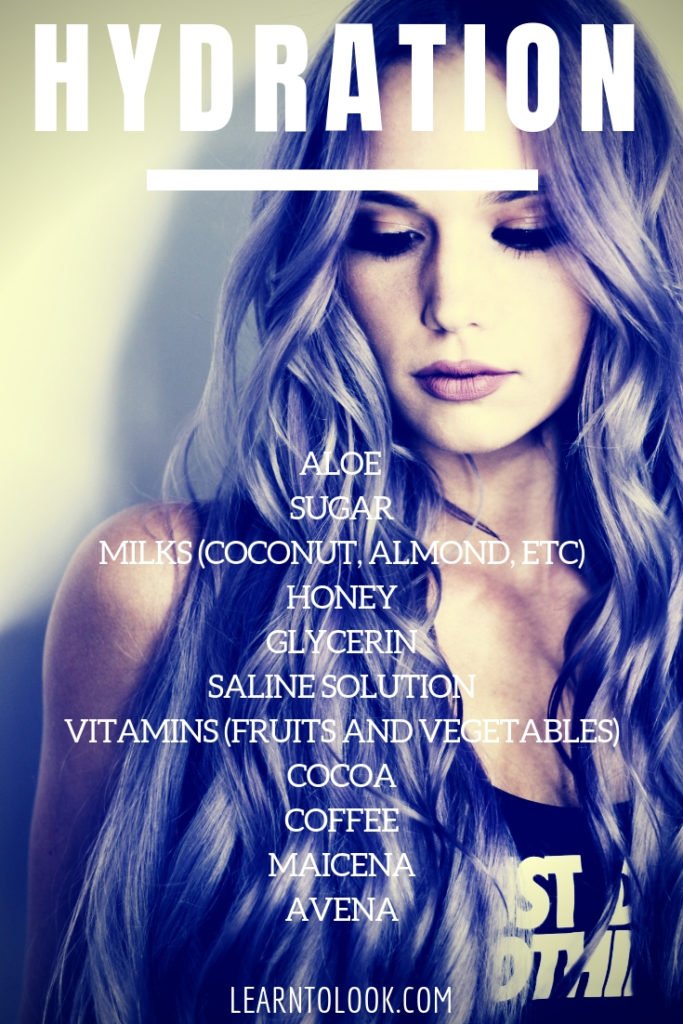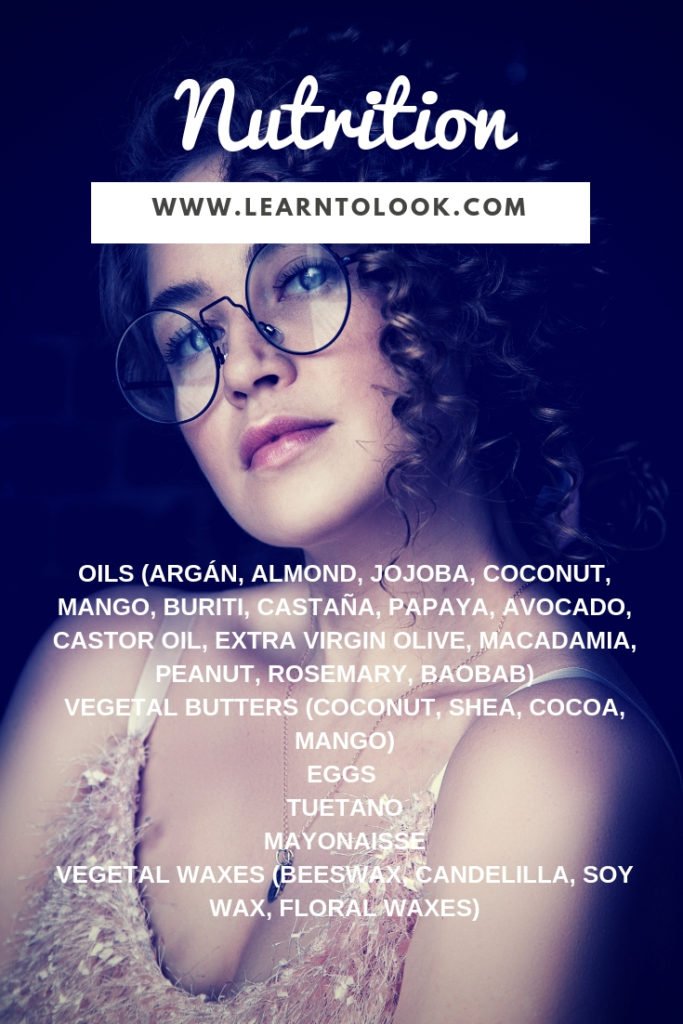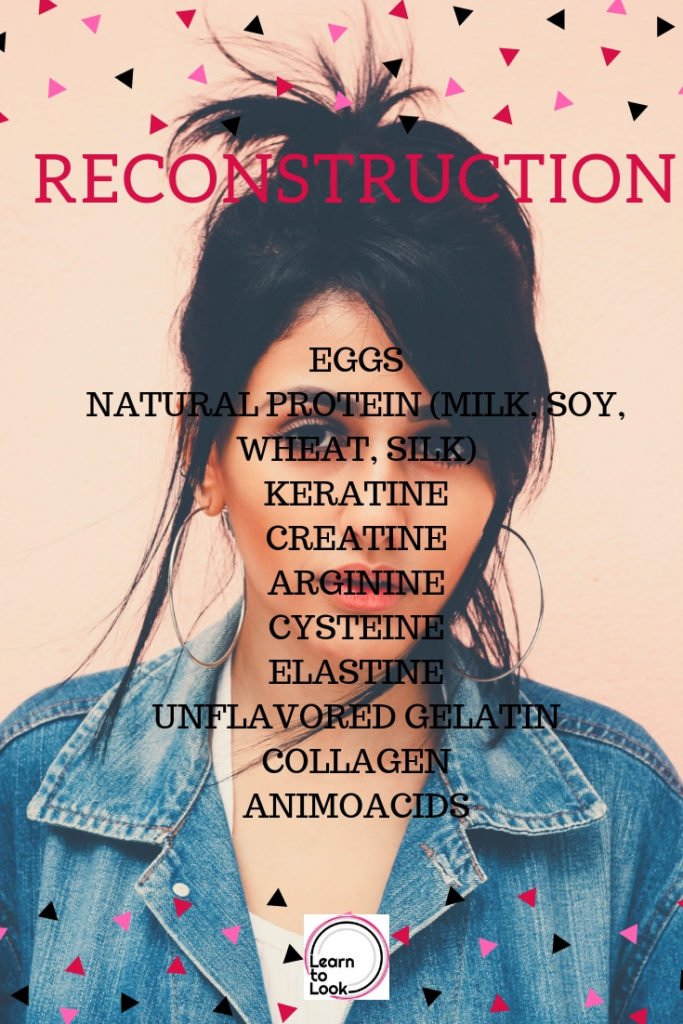Surely you have experienced many of the signs your hair shows when it’s lack any of these 3 things: hydration, nutrition and reconstruction.
Frizz, cracking and dryness are the most common symptoms of a hair that needs care.
It is important to know this: if you use silicones, petroleum based products or other petroleum derivatives, or you have formaldehyde-based chemical treatments (chemical cauterization, straightening, keratins with formaldehyde, Botox, etc), the hair will not absorb any treatment you give.
If you want them to work, we propose to do a deep cleaning with any shampoo with sulfates and without silicones. Then you can start any treatment.
Hydration
If your hair has frizz, is unmanageable, and it sticks with any smell of the street (the cigar that was smoked next to you waiting for the bus, or the smoke of the grill you passed by this morning), then needs hydration.
It is very common the lack of hydration, because due to the heat and the use of chemicals that make our hair porous, is the first thing that is lost in the course of the day. That’s why more than 90% of women suffer from frizz or “cloud effect”.
Why is this happening? The causes are several and many of them inevitable. The heat, the use of chemicals, washes too frequent. Luckily, is easy to fix.
Hydration begins on the inside, and should be reinforced with products at least once a week. The ideal, depending on the porosity of the hair, would be once a week for very porous hair, twice for medium porosity hair, and three times for low porosity hair.
We know, it sounds unnatural. But keep in mind that hair with more porosity (which usually had more chemical treatments and are more damaged) also need a greater number of treatments to nourish and restore, and hair becomes saturated if we make too many treatments in only one week.
So we’ll only do 3 at the most.
And so how do we hydrate it? To begin with, it is important to hydrate with at least 2 liters of water per day (this you will know) and also to follow a diet rich in vitamins. I mean, eat lots of fruit.
Once you have those two steps, you can choose the right products that really hydrate your hair, following this little guide.
EXTRA TIP
That's how you take care of your hair from the basics.
To give hydration to your hair, you can make masks up to 3 times a week.
Any well-chosen commercial mask (below we teach you how) will do the job.
But we always prefer the natural, and that way you don’t spend an entire salary on hair products.
1.- First, the natural
Aloe Vera or Aloe is a great moisturizer. You can place it after the shampoo (or first conditioner if you do Cowash) and leave it in the hair for at least half hour (avoid the scalp, and if you do not have oily hair you can place it on there sometimes). Then rinse it with plenty of water, and put the end conditioner.
Sugar is also a great ally of hydration. You can add it to any other moisturizing ingredient to enhance your treatment, as it retains the water in an excellent way.
The milks (almonds, coconut, soy, cow’s milk, etc) are also allies of hydration for your hair. But do not place them alone, because they provide a light hydration and you can always empower them with some other ingredient.
Honey might surprise you by placing it with milk and sugar. Moisturizes in depth and leaves hair soft and shiny.
Glycerin is a great container of water as well. But don’t use it alone: add it to some commercial mix or mask (just a teaspoon), and then tell me about it!
As you can see, the common saline solution (also known as physiological solution or physiological saline), acts of wonders in the capillary strand. This is sodium chloride at 0.9% in water and, if you have basic knowledge of chemistry, you can do it home-made. This marvel quickly hydrates and powers any other commercial ingredient or mask (with only 2 teaspoons).
Now, the great ally: the vitamins. As you know, you can find a worm of these in any fruit or vegetable, but only some of them will have great impact on your hair: strawberries, banana, guava, papaya, maracujá, citrus, carrot, avocado. Made puree and mixed with other ingredients (milk, glycerin, yogurt, eggs, sugar or physiological solution), will achieve an instantaneous and noticeable change in your hair. You’ll notice it more docile, shiny and soft.
You may have noticed, yogurt is also a moisturizing agent. You can use it only for an average hydration, or boost it for a shock hydration.
An incomparable moisturizer will be cocoa. Yes, the one you put in the milk or use for cooking. Power any commercial moisturizing mask, and you can also use it with other moisturizing ingredients.
The same goes for coffee. In addition, many say it helps with hair growth, although not scientifically proven its impact on this topic. You can place it directly if it is instant coffee. The coffee beans need to be prepared and dissolved before being used in the hair.
Another ingredient whose properties few know is cornstarch. Already cooked, it can be used alone or enhanced with other moisturizing agents.
Finally, we must not forget the oats. You can prepare it in hot water or milk to release its properties. If you add honey, you’ll have a deep moisturizing mask that will leave your hair soft and very shiny.
Don’t forget that hydration is a continuous treatment, and with time and constancy the best results are achieved.
If you have a very dry hair, you may get the hydration at the beginning and then fluffy hair as never has. This is because the hair is going to keep looking for that hydration that it needs so much, and it will take it from the humid environment. There you see that the strands of hair literally come out of gravity to take from the environment the moisture it seeks (the evil famed frizz).
So if you have a cloud-effect start, don’t worry: It’s a sign that you’re on the right track. After a few weeks the hair will go down and showing more manageable.
EXTRA TIP
Hydration and deep nutrition: how to put magic on your hair.
2.- Then, commercial masks
Easy, we’re not promoting anything here.
We’re just telling you what you should look for in a commercial mask so it can really act like a hydration treatment. Of course, any mask that has the ingredients we told you about just above, can be use as a hydration mask.
You can always use it alone, if those ingredients (at least one of them) are in the top 5 ingredients (I personally prefer top 3, but top 5 is acceptable).
If not, you may see a lot of masks without silicone (that’s so important, always non-siliconed) with their last ingredient such as “aloe extract”. That means it has a lot of chemicals and then a 0.000000001% of aloe. Not good. It’s just water with alcohol, believe me.
If that’s the case, or the ingredients are in 6th place, easy: you can always use it with a few natural ingredients to empower the mask. Give it a try with sugar, or saline solution, even a teaspoon of glycerin.
High porosity hair may always use commercial masks with this ingredients in their top 3 or 5, even if you will mix them with natural ingredients. We need a shock treatment here!

Nutrition
If your hair is dull, brittle, and looks dry, it lack of nutrition.
Nutrition is also known as humidification, but you should not confuse this term with hydration.
Everything oily is going to nourish your hair, and you should do it according to your porosity: if you have low porosity hair, once every 15 days. If it’s average porosity, add more nutrition in between. If you are high porosity, once a week. It is important to respect what each type of porosity needs so you won’t to saturate the hair.
Now to the important thing: how do we nourish the hair?
The most intense and fast is to use natural oils. As far as possible, virgins and organics. But beware, there are some oils that cannot be absorbed by the hair. Those who do can are: Argan, almonds, jojoba, coconut, mango, burití, chestnut, papaya, avocado, castor, sesame, extra virgin olive, macadamia, peanut, Rosemary, baobab. Oils that do not penetrate the capillary fibre are: cotton, wheat, sunflower, maize, grape, soybean, flax or flaxseed, Rosehip, Calendula.
The best way to nourish using oils is to leave them all night. I know, it’s uncomfortable, but if we try to use a hat to not spread it and a towel on the pillow, it gets easier.
When you remove it, it is important to emulsify.
How to Emulsify: Emulsify is to unite an oily phase with another aqueous. There are emulsifying ingredients that are used for cosmetics, but we will do it to rinse the oils and make sure that there are no traces left in our hair.
The procedure is easy: we add shampoo without silicones nor petroleum based products, or first conditioner (if you follow Cowash method). We put it as usual and start massaging. It’s going to get hard, so you have to be patient and go adding water very slowly.
When you have covered all the hair, let it rest for at least 15 minutes to soften the oil and bind it to the emulsion. Later you rinse it with plenty of water and continue with the conditioner.
Beside the oils
Another way to nourish is with ceramides. They are a natural lipid of the hair and skin, which can be obtained in synthetic form in the pharmacies or houses of professional products for the hair. Make sure they are pure, otherwise it could contain silicones and frustrate the whole purpose of nutrition.
Vegetable butters are also nutritious. The best known is the Shea, but the cocoa butter, mango and coconut, are just as good. If you have the opportunity, don’t hesitate to try them! Let them act at least 40 minutes and get them off emulsifying.
The egg also provides moisture. You can use it only for average nutrition, or intensified with another ingredient for deep humidification. Do not leave it all night, as the clear turns the hair hard and can cost too much to remove. (If you want, you can use only the yolk directly). Surprisingly, the marrow also serves. Place it alone or with some oil, and note the powerful transformation of the capillary strand. This insurance you know: mayonnaise. For years our mothers and grandmothers have used it in their hair, and rightly so! It nourishes it in an integral and very noticeable way, besides leaving it with brilliance and softness. Finally, the vegetal waxes are very used in the capillary cosmetics for their nutritive properties. Beeswax, Candelilla, soy wax or some floral waxes are the most used.
In relation to commercial masks, nutrition works exactly like hydration. Look for the nutritious ingredients among the first 5 of the label, and use it only or boosted.

Reconstruction
If your hair is elastic (gum or goop) or breaks easily, is without force or falls, is a sign that you need a reconstruction. Hair is losing its own proteins and amino acids with chemical treatments, heat, and excess sulfates. This makes ir weak to the point of causing the famous signs of death of the hair (although the hair itself is not something alive).
The bad news is you just found out that hair has no life.
The good news is it’s already dead, so you just have to keep it that way and avoid it from breaking or falling. And it’s not an impossible task.
The first thing you need to know is that the most damaged hair can do two reconstructions a month. Three, in a very extreme case. The hair of medium porosity, once or twice a month. Low porosity, once a month. Remember that if you do it more often and your hair does not need it, it will saturate and will be weighed by an amount of proteins and amino acids more than it can absorb.
Now, the ingredients and components that can really repair your hair are many, and you can get them in drugstore, pharmacies or supermarket gondola.
The egg in addition to being nutritious, also repairs. It has a lot of protein that your hair can absorb, but it does not do a very deep repair if it’s alone. So try to put it with something else.
Natural proteins (milk, soy, wheat or silk) are the most common thing you will find among the ingredients of a restorative cream (as long as it does not have silicones or petroleum based products). Also keep in mind for choosing your shampoo or conditioner if you have high porosity hair.
Keratin is a sulfur-rich substance, of protein origin, which constitutes the last layers of skin, hair and nails. To penetrate the capillary strand we must use it already hydrolyzed. There are numerous products with keratin, but it is important that they do not contain formaldehyde (most famous “keratin shocks” have it).
Arginine, cysteine, creatine and elastin are other components of protein origin that affect the formation of hair fiber and its health. In other words, in addition to reconstituting it, they help hair growth. Therefore you will see them regularly in tablets of dietary supplements formulated to strengthen the hair and nails.
The flavorless gelatin also provides large amounts of protein, and is easy to get for home treatments, so one of the most chosen options to rebuild hair at home.
Collagen is the most abundant protein in all our bodies, it’s composed of animo acids like glycine, proline, Hydroxyproline and arginine. It can be synthesized, but it is always better to encourage your own body to produce it through certain foods.
Garlic, tomato and onion are rich in sulphur, which stimulates the formulation of collagen. Also some fruits and vegetables like apple, beet and strawberries are rich in lycopene, which is also antioxidant and stimulates the synthesis of collagen. In general, any amino acids that forms the keratin can be acquired separately and keratinized once it touches the hair.
We find them easily in food: milk and derivatives (yogurt, cheese, butter), eggs, fish and meat. For vegans, the best options are cereals, legumes, vegetables, seeds and nuts.

So that’s what it’s all about. Give your hair what it needs according to the signs it shows, and it’ll always be healthy.
You can combine and enhance the ingredients and tell us what was best for you!